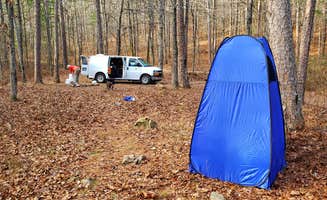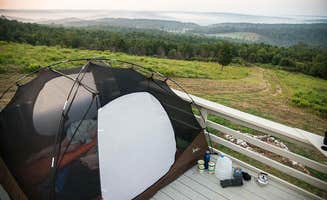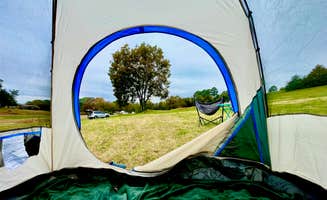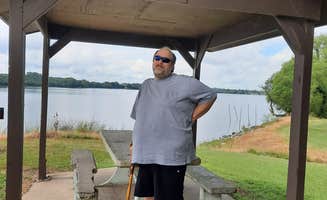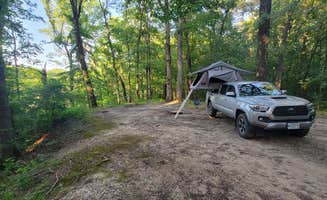Dispersed tent camping around Little Rock, Arkansas centers primarily in the Ouachita National Forest region where elevations range from 600 to 2,800 feet. Most sites sit on forestland with pine and hardwood coverage, creating natural shelter from summer heat that routinely exceeds 90°F between June and September. Winter camping remains viable with average lows rarely dropping below freezing in the immediate Little Rock vicinity.
What to do
Wildlife observation: The Mike Freeze Wattensaw Wildlife Management Area offers excellent opportunities for viewing native Arkansas species. According to one camper, "We woke up to birds, singing, and trees rustling. It was very beautiful and peaceful." Others report seeing beavers, frogs, and various bird species around the numerous ponds.
Water activities: At Iron Springs near Jessieville, visitors can enjoy "a beautiful area for a picnic, hike, or swimming in the Iron Springs." The site functions primarily as a day-use area with picnic facilities and swimming access.
Fishing: Multiple dispersed sites provide fishing opportunities without crowds. A visitor at Mike Freeze Wattensaw WMA noted "a large pond with nearby primitive camping for free," ideal for anglers seeking solitude. According to reviewers, the area hosts "ducks, beevers, frogs and more."
Hiking: Dispersed sites along Forest Road 132 connect directly to the Ouachita National Recreation Trail. A camper reports, "Access to the Ouachita National Recreation Trail located nearby," making these sites popular with hikers looking for trail-adjacent tent camping near Little Rock.
What campers like
Quiet nights: Tent campers frequently mention the peacefulness of dispersed sites. At Brown Creek Cascade Dispersed Campsite, one visitor noted, "Very quiet; no vehicles passed by during the night. The sound from the creek was soothing."
Natural soundscapes: Campers report enjoying natural sounds at these primitive sites. At Mike Freeze Wattensaw WMA, a reviewer mentioned, "The birds and frogs sang all evening," providing a natural soundtrack to their camping experience.
Free overnight stops: Most dispersed sites offer no-cost camping options. A camper at Dispersed FR132 Ouachita National Forest found that while initial sites were "close to the road and some trash," spots further in (5-10 miles back) were "amazing" though roads can be steep.
Hammock-friendly locations: Many sites feature mature trees ideal for hammock camping. A Brown Creek visitor noted, "Large pine trees on the site. Hammock camping is possible," making this location suitable for those who prefer hanging shelters to ground tents.
What you should know
Access challenges: Forest roads can be difficult to navigate. One camper at Mike Freeze Wattensaw WMA warned, "The road access is gravel, but LARGE gravel that we are surprised didn't ruin our tires," suggesting vehicles with low clearance may struggle.
Limited amenities: Tent campers must be fully self-sufficient. According to visitors at South Fourche, "It has a small mens and womens bathroom. Each site has a picnic table and a metal fire pit with a grate," which represents more facilities than most dispersed sites offer.
Seasonal considerations: Summer heat and insects can be challenging. One camper at Mike Freeze noted "flies so thick we didn't want to get out of our truck," suggesting spring and fall might offer more comfortable tent camping conditions near Little Rock.
Navigation confusion: Finding specific sites can be difficult. A Mike Freeze visitor reported, "You cannot trust either Apple or Google maps to get you here by these coordinates. Also, 'here' is a relative term," recommending campers "start looking for very small signs that say 'designated camping area.'"
Tips for camping with families
Bring plenty of water: No reliable water sources exist at most dispersed sites. At Camp Robinson Dispersed Site, visitors mentioned camping "by lake Conway" but noted the lake has sometimes "been partially drained to allow work to be done on stumps," affecting water access.
Plan for weather variables: Arkansas weather can change rapidly, especially during spring and fall. One camper at Brown Creek Cascade recommended: "Bring a chair if you want a comfortable seat, also hard to find decent wood to burn, had to walk a bit to find."
Be aware of hunting seasons: Wildlife Management Areas allow hunting during specific seasons. A Brown Creek visitor noted, "Sunday morning there were hunters out, so hearing gunshot pretty close to camp," which could be concerning for families with young children or pets.
Consider lake access sites: Some areas offer easier access for children. A visitor at Camp Robinson described it as "isolated but not too far out," with good cell reception, making it more suitable for families needing connectivity.
Tips from RVers
Site selection importance: Most dispersed camping areas only accommodate smaller RVs and truck campers. At COE Nimrod Lake Carter Cove Campground, a camper noted "The sites are a little tight for larger rigs to maneuver and many sites don't have water."
Road condition awareness: Forest roads can damage larger vehicles. One Mike Freeze visitor abandoned their stay because of road conditions, stating they were "surprised [the gravel] didn't ruin our tires," suggesting smaller RVs or high-clearance vehicles fare better.
Length restrictions: Most dispersed sites accommodate only smaller rigs. A camper at Brown Creek Cascade explained the site is "suitable for tent camping, car camping, camper vans & truck campers. Two vehicles can easily fit on this level site," indicating full-sized RVs wouldn't fit.
Limited hookups: Even established campgrounds have minimal services. A visitor to COE Nimrod Lake noted, "The water connections were kind of far from the site so had to use longer hose. Did have 50 amp power though," which represents more amenities than dispersed sites typically offer.


